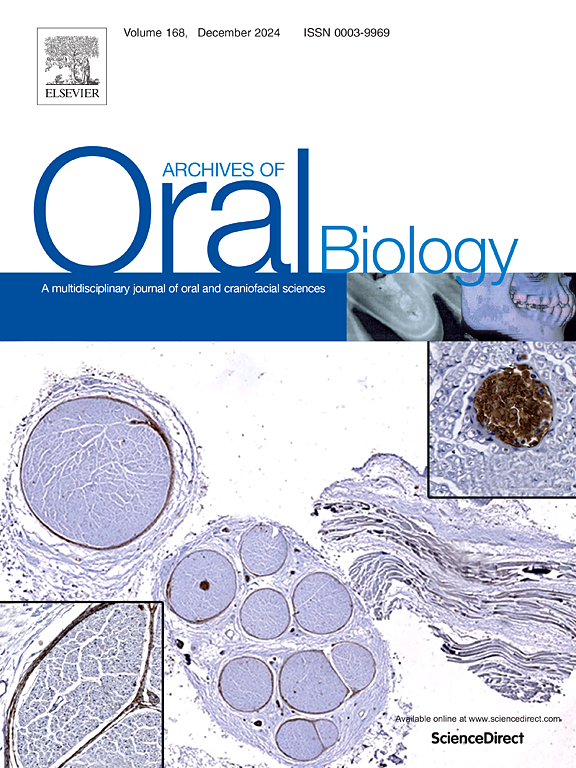Salivary proteome and microbiome in pregnancy and postpartum: An exploratory study on the relation with arterial hypertension
IF 2.1
4区 医学
Q2 DENTISTRY, ORAL SURGERY & MEDICINE
引用次数: 0
Abstract
Objectives
Arterial hypertension (AH) influences salivary gland physiology and oral health, being associated with a higher incidence of periodontal disease in pregnant women. Evidence points to a bidirectional relationship between the oral microbiota and blood pressure regulation. Therefore, this study aimed to characterize the oral health of pregnant women and AH-associated changes in the salivary proteome and microbiome during pregnancy and postpartum.
Design
Ten healthy women and ten women with AH were enrolled. Saliva was collected during pregnancy and six months postpartum. The salivary proteome was characterized by shotgun label-free mass spectrometry analysis. Specific proteins were validated through parallel reaction monitoring (PRM). The oral microbiota was characterized via 16S rRNA gene amplicon sequencing (V4 region). The periodontal health and the caries history was assessed during pregnancy.
Results
Pregnant women with AH had lower junction plakoglobin (JUP)- and desmoplakin (DSP)-specific peptide levels than healthy women, confirmed by the PRM approach. The levels of these proteins correlated negatively with periodontal health indexes, which were higher in pregnant women with AH. In AH, nitrate-reducing microorganisms had lower abundance, correlating positively with JUP and DSP-specific peptides.
Conclusions
The salivary proteome and microbiota are shaped by AH during and after pregnancy. Further research is required to understand the underlying mechanisms impairing oral health in AH.
妊娠和产后唾液蛋白质组和微生物组与高血压关系的探索性研究
目的动脉高血压(AH)影响唾液腺生理和口腔健康,与孕妇牙周病的高发病率有关。有证据表明口腔微生物群与血压调节之间存在双向关系。因此,本研究旨在描述孕妇的口腔健康状况以及妊娠和产后唾液蛋白质组和微生物组的ah相关变化。10名健康女性和10名患有AH的女性入组。在怀孕期间和产后6个月收集唾液。唾液蛋白质组采用散弹枪无标记质谱分析。通过平行反应监测(PRM)验证特异性蛋白。通过16S rRNA基因扩增子测序(V4区)对口腔微生物群进行鉴定。评估怀孕期间的牙周健康和龋齿病史。结果妊娠AH患者的结血小板红蛋白(JUP)和desmoplakin (DSP)特异性肽水平低于健康妇女,PRM方法证实了这一点。这些蛋白的水平与牙周健康指数呈负相关,而牙周健康指数在患有AH的孕妇中更高。在AH中,硝酸盐还原微生物的丰度较低,与JUP和dsp特异性肽呈正相关。结论妊娠期和妊娠后AH对唾液蛋白质组和微生物群有影响。需要进一步的研究来了解AH损害口腔健康的潜在机制。
本文章由计算机程序翻译,如有差异,请以英文原文为准。
求助全文
约1分钟内获得全文
求助全文
来源期刊

Archives of oral biology
医学-牙科与口腔外科
CiteScore
5.10
自引率
3.30%
发文量
177
审稿时长
26 days
期刊介绍:
Archives of Oral Biology is an international journal which aims to publish papers of the highest scientific quality in the oral and craniofacial sciences. The journal is particularly interested in research which advances knowledge in the mechanisms of craniofacial development and disease, including:
Cell and molecular biology
Molecular genetics
Immunology
Pathogenesis
Cellular microbiology
Embryology
Syndromology
Forensic dentistry
 求助内容:
求助内容: 应助结果提醒方式:
应助结果提醒方式:


